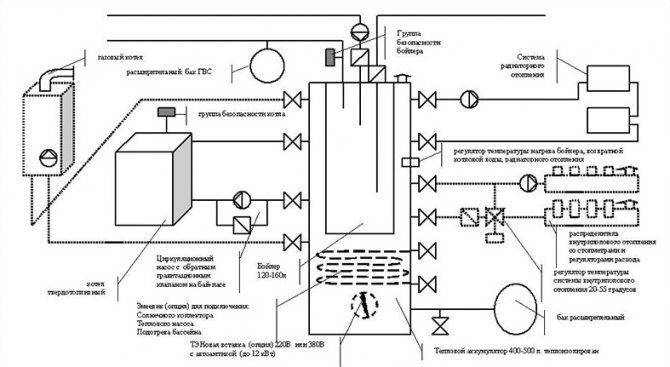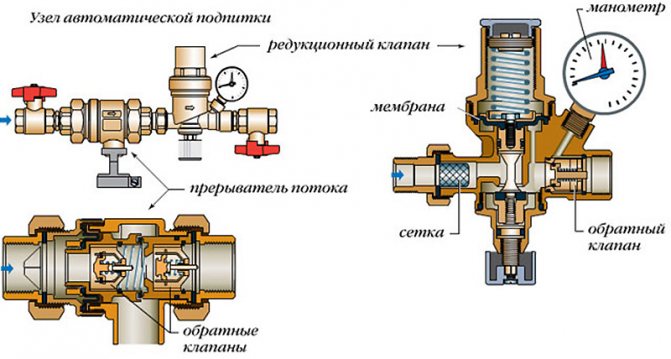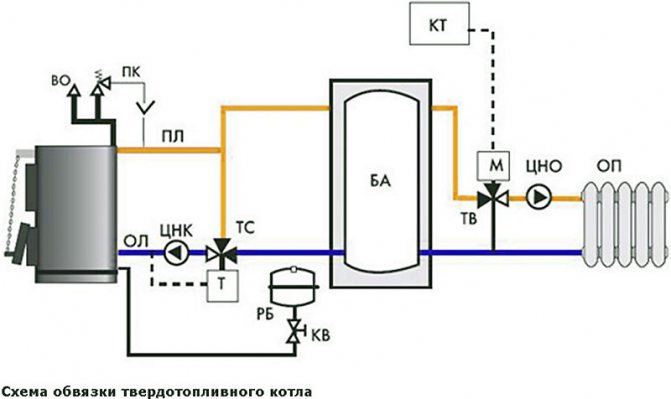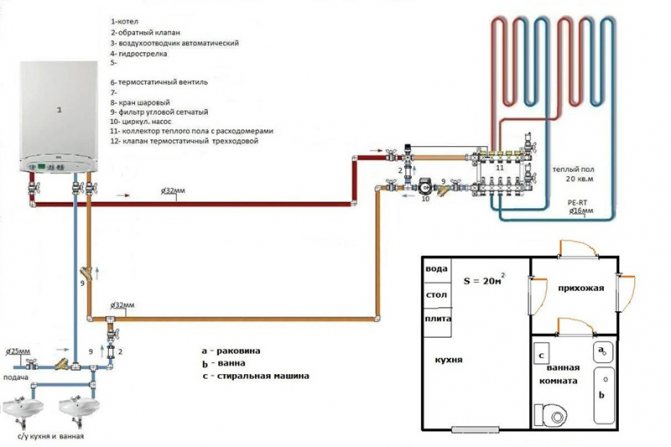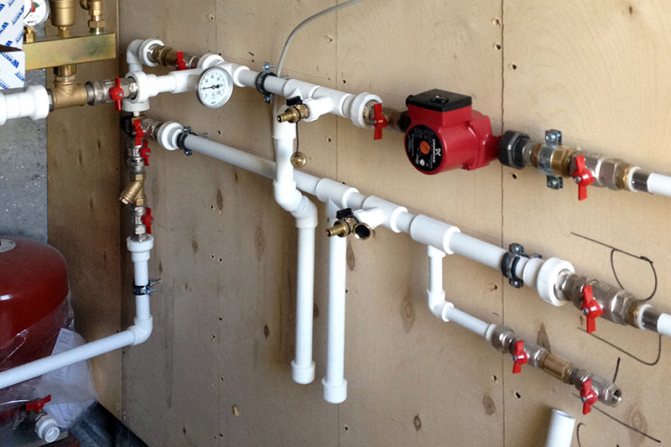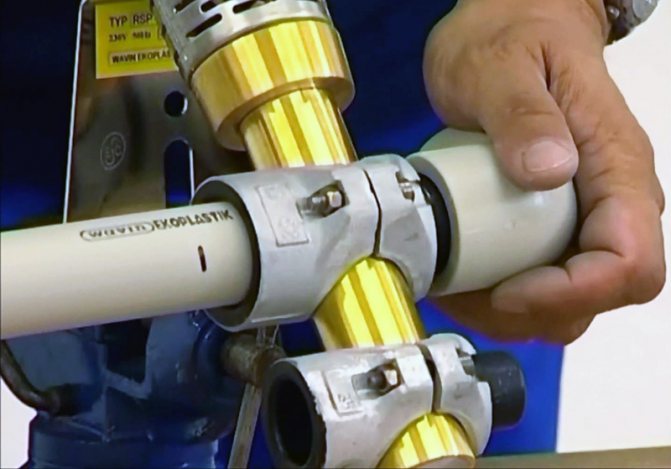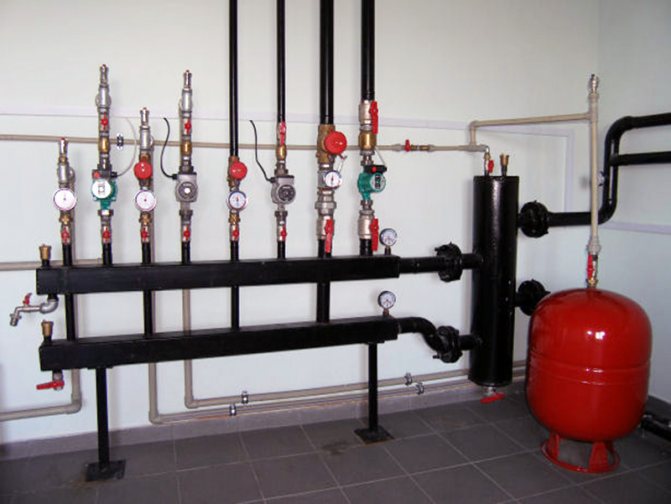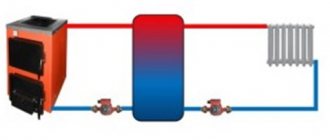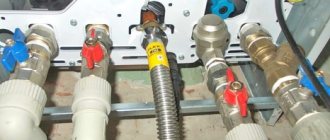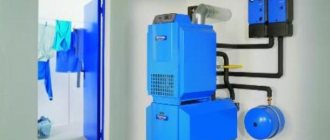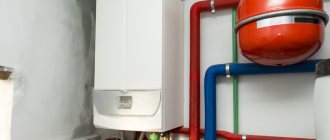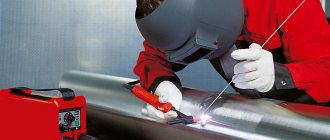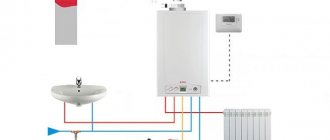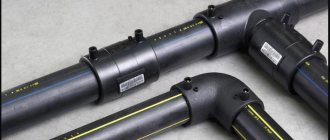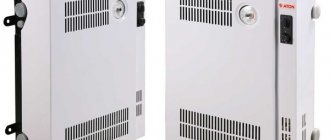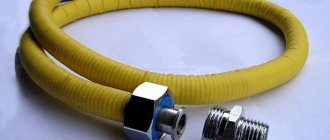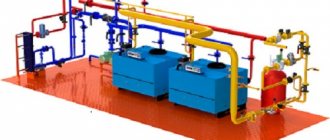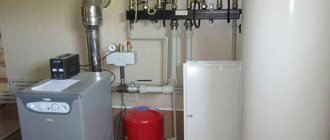Connection types
Autonomous heating can be realized using:
- Wall-mounted single-circuit boiler with electronic ignition, providing forced circulation in the radiator system.
- Non-volatile wall-mounted or any floor-standing equipment.
- Non-volatile boiler, which is installed in an open circuit with natural circulation.
- Heating circuit modifications for underfloor heating. A low temperature of the coolant is characteristic here.
- Single-circuit boiler connected to a hot water supply system. We are talking about a piping scheme for a gas heating boiler with a boiler
- Double-circuit boiler providing heating and hot water supply. In this way, a double-circuit gas boiler with a boiler is connected, which is quite popular.
- When the DHW circuit has water recirculation. Thanks to the constant movement of water in the circuit, heated towel rails connected to the hot water supply are kept hot. It also provides a high flow rate of hot water to the mixers.
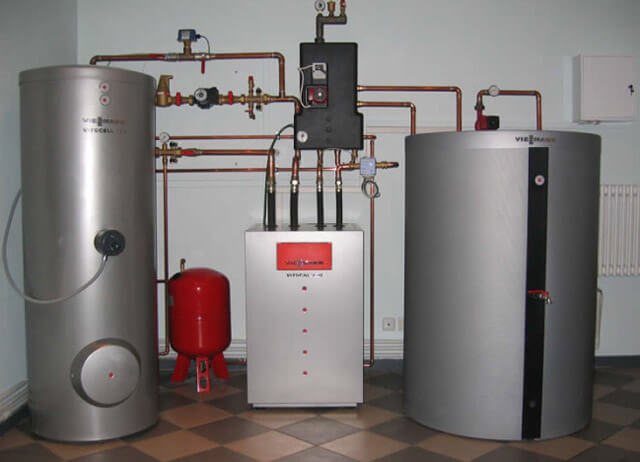
If the DHW wiring of a significant length does not have water recirculation, it will need to be drained for a long time before heating. In addition to the well-known inconveniences, this also entails financial losses. The same applies to the dead-end distribution of hot water supply without recirculation. In this case, heated towel rails connected to the wiring occurs exclusively during water intake.
Boiler piping with polypropylene pipes - specificity and advantages
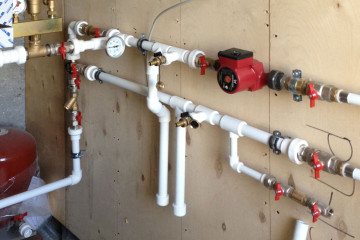

Any boiler must be connected to a heating and hot water supply system.
The entire piping system is tied with strapping.
The piping of boilers with polypropylene pipes is popular.
Choosing a polypropylene pipe for piping a boiler
The choice of the type of pipe depends on its purpose, namely, on the pressure of the coolant and its temperature:
- PN10 pipes - used in cold water supply systems with water temperatures up to +20 degrees, as well as when installing underfloor heating with a working environment temperature not higher than 45 degrees; this is a thin-walled version of pipes that can withstand pressure within 1 MPa;
- PN16 pipes - used in the distribution of cold water supply pipelines with increased pressure in the system, as well as in central heating pipelines with reduced pressure in the system;
- pipes PN20 - universal products used for both cold and hot water supply (with a temperature in the system up to +80 degrees); withstand a nominal pressure of 2 MPa;
- PN25 pipes are products reinforced with aluminum foil reinforcement and used for the installation of hot and cold water supply pipes with a nominal pressure of up to 2.5 MPa.
How to choose an electric boiler and how to use it, read here. If you have an oil-fired boiler, the article on oil-fired universal burners will come in handy.
You will also find useful information about waste oil burners https://otoplenie-pro.com/gorelki-kotlov-na-otrabotannom-masle-2/
Propylene pipes have a different structure:
- Reinforcement with solid aluminum sheet and perforated aluminum sheet. It is applied to the outside of the pipe.
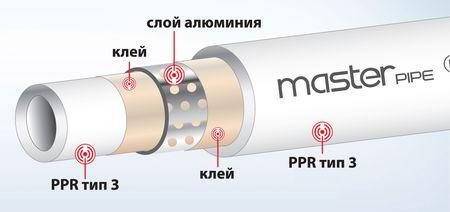

- Aluminum reinforcement is sandwiched between the inner and outer polypropylene layers.
- Fiberglass reinforcement is also done between the polypropylene layers.
- Composite reinforcement is a mixture of polypropylene with glass fiber.
The most suitable type of polypropylene for heating is pipes with composite reinforcement.
Equipment and tools for working with polypropylene pipes
A special soldering iron and the necessary couplings are used to connect the pipes. After heating the soldering iron, a pipe is inserted into it and the polypropylene begins to melt. Then the 2 elements to be connected are tightly connected. Freezing occurs immediately. Special scissors can be used to cut pipes.
If there is no experience with polypropylene, then you can buy an inexpensive material and practice on it, and then proceed with the installation of the heating system.
Gas boiler piping
Each boiler has the necessary fittings for connecting pipelines. There are a number of requirements that must be met when installing the boiler.
General requirements for the installation of the heating unit
Floor standing models should not be the highest point of the heating system, otherwise air pockets will form in the boiler.
If the installation of the boiler at the lowest point of the heating system is impossible, then it is necessary to install an air vent - a mechanical device that automatically releases the accumulated air.
The hot water heating system must be equipped with a membrane expansion tank, which acts as a compensator for pressure drops in the heating system.
The presence of a safety group is mandatory - this is a mechanical safety valve and a pressure gauge. When the pressure in the heating system rises above the permissible value, the valve will open and the pressure will be released.
Strapping
The pipelines are connected by soldering polypropylene pipes. The use of polypropylene opens up the possibility of creating a heating system of any complexity.
When operating a gas boiler, the gas supply must be carried out using a rigid connection. For this, you can use a steel pipe with an American nut.
Paranite can be used as sealing gaskets between the pipelines to be connected. It is forbidden to use rubber, tow and fum tape, as these materials are not suitable for high temperatures.
Solid fuel boiler connection
The operation of gas, electric and diesel boilers is equipped with protection and automation systems. This makes it possible to instantly shut down the unit in an emergency.
Features of solid fuel boilers
The burning of coal or firewood cannot be stopped instantly, therefore, if the power is cut off, the circulation pump will stop, and the heating of the coolant will continue. This will lead to an unlimited increase in pressure in the heating system. There are systems of protection against such situations.
- Automatic cold water supply.
- Installation of uninterruptible power supplies.
- Gravity contour.
- The presence of an additional emergency circuit.
The piping of a solid fuel boiler plays a very important role in its further safe operation, therefore it is better to entrust this process to professionals.
The gravity circuit is a natural circulation heating system. Its work is based on the laws of physics: the heated coolant always tends upward. The heating system is a closed circuit, so hot water will force cold water back into the boiler, creating continuous circulation.
For the functioning of the natural circulation heating system, a number of requirements must be met:
- The boiler must be installed at the lowest point of the entire heating system so that water can drain into the unit by gravity.
- The horizontal sections of the pipelines must have a slight slope towards the boiler.
- To improve the distribution of the coolant between the radiators, pipes of a larger diameter will have to be used.
- The greater the height difference between the boiler and the heating radiators, the more intense the circulation will be.
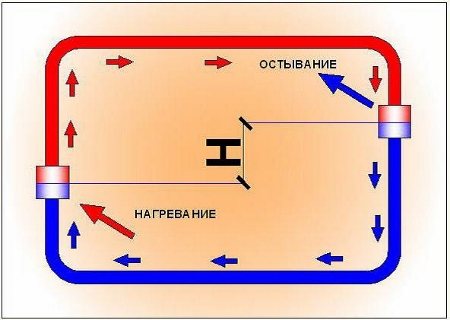

The natural circulation heating system is convenient and reliable, and most importantly, it is non-volatile.
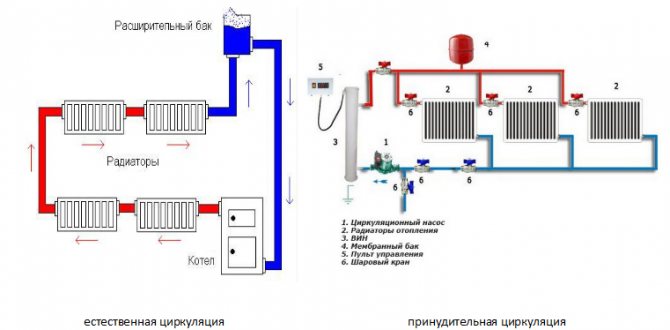

Forced circulation of the coolant requires the installation of additional protective and monitoring sensors and equipment, and this is an additional cost.
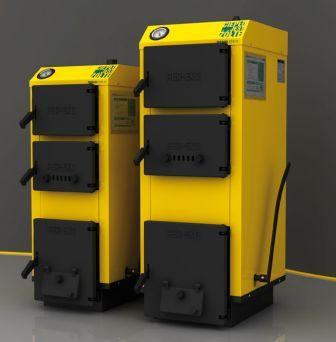

Read about automatic control of burners of heating boilers in this article.
You will also need information about the safety automation of the gas burner device.
How to choose a long-burning solid fuel boiler and fuel for it, read the link.
Connecting a double-circuit boiler
Double-circuit units provide heat to the room and heat water for household needs. The piping scheme when installing a double-circuit boiler is a little more complicated, since it is necessary to connect the hot water supply system.
So that the installation process does not cause difficulties, it is necessary to make a drawing of the future arrangement of pipes, taking into account all the features of the arrangement of rooms and furniture.
If the heating system has a complex structure and many radiators, it is better to divide it into several CA independent circuits. To evenly distribute the coolant, you need to install a collector.
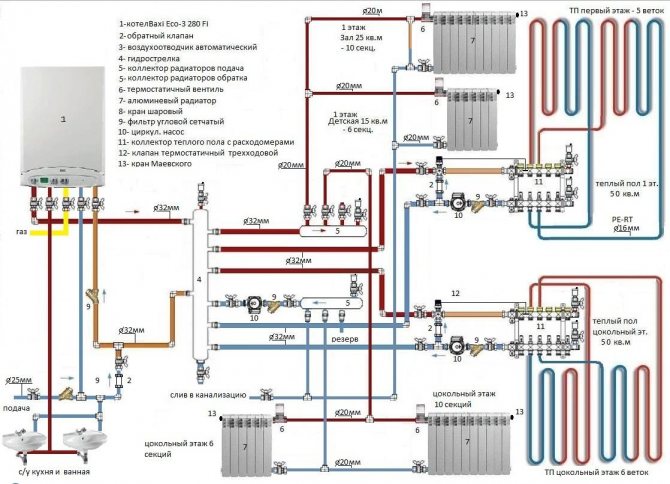

The choice of the pipe diameter must be made in accordance with the hydraulic calculation. An increase in the diameter of the pipes will lead to a drop in the pressure of the coolant, but will not affect the improvement of heating.
You can use the average values of pipe diameters for heating: for polypropylene pipes 20x3.4 is the norm.
Proper piping of heating equipment affects the efficient and safe operation of the entire heating system.
Harness complete set
The harness includes the following elements:
- Diaphragm expansion tank... Designed to compensate for surges in the volume of the coolant during heating. Such a need arises in closed heating systems. Inside the container there is an elastic membrane that divides it in half. One half contains air or nitrogen (in this case, the walls of the tank will not corrode). When the volume of the coolant increases, this provokes gas compression: as a result, the total pressure in the system remains practically the same. The standard volume of the expansion tank is 10% of the amount of the heating medium. For a rough calculation, a ratio of 15 l / kW of heating boiler output is usually used.
- Safety valve... Performs a discharge of excess coolant when the pressure in the circuit rises to dangerous values. As a result, pipes and radiators are prevented from bursting. A drainage pipe is provided to drain water into the sewerage system. If this valve is operated regularly, this indicates that the expansion tank has insufficient capacity.
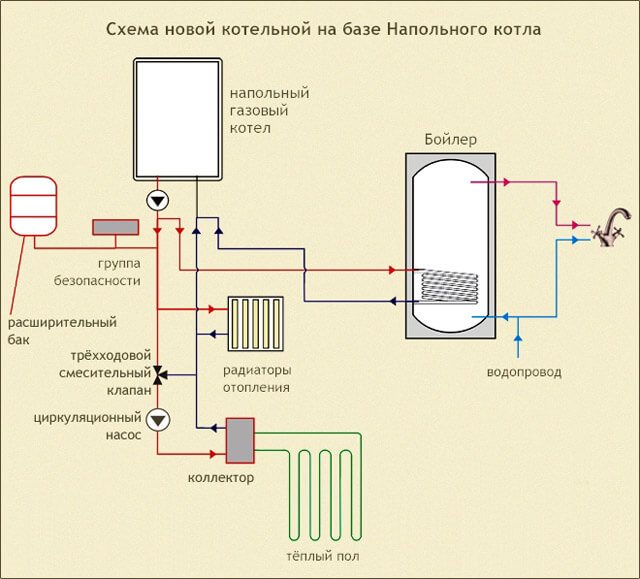

- Air vent... In the event of air jams, they are brought out in automatic mode. We are talking about air accumulations formed in the system as a result of draining the coolant. They cause hydraulic noise and additional obstacles to normal circulation in the mode of low hydraulic head.
- Pressure gauge... Monitors the operating pressure in the circuit. It is sometimes replaced by a thermomanometer, which additionally records the temperature. The scale of the device should have a markup up to 4 atmospheres.
- Open expansion tank... Replaces expansion tank, air vent and open circuit safety valve. In this case, the system does not face the problem of overpressure. To connect the tank communicating with the atmosphere to the DHW system, a tap is used: this ensures the recharge of the circuit.
- Indirect heating boiler... Inside this thermally insulated tank with a heat exchanger, hot water is prepared.The heat is supplied by means of the heating medium flowing through the heat exchanger from the heating system. This element is included in the piping diagram of a gas single-circuit heating boiler; the connection of an indirect heating boiler must be carried out by specialists.
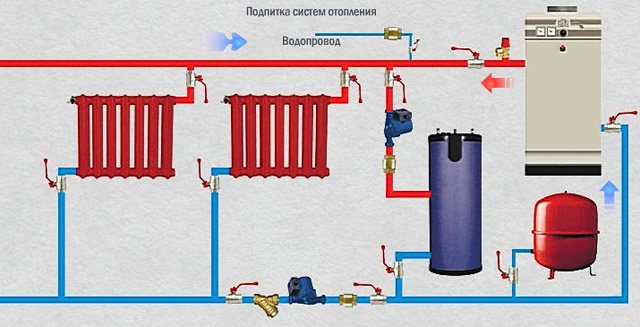

- Circulation pump... Thanks to him, forced circulation of the coolant through the heating circuit is carried out. When choosing a suitable pump, pay attention to the level of pressure it creates and performance. The power consumption indicator in modern models is regulated within 50-200 watts. Due to this, the speed of movement of the coolant can be changed, depending on the situation.
- Hydrostrel... Several heating circuits can be connected to this container with nozzles. Its task is to combine the supply and return pipes. As a result, it becomes possible to bring together systems with different temperatures and speed of movement of the coolant, smoothing out their mutual influence.
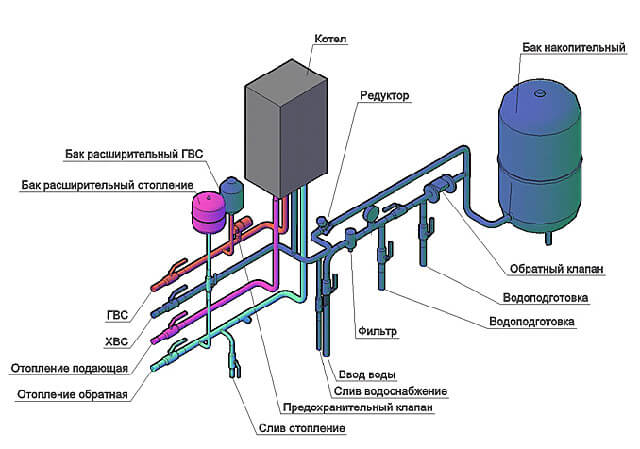

- Coarse filter... Inside the sump with a filter mesh, large particles in the water are retained. Most often we are talking about sand and scale. As a result, clogging of the thin tubes of the heat exchanger in the gas boiler is prevented.
- Two- and three-way thermostatic mixers... Thanks to them, it becomes possible to create recirculation of the coolant, the temperature of which is an order of magnitude inferior to the indicators in the main circuit. A thermal head is used to control the mixer shutter. The valve changes its position in response to the temperature of the sensing element.
Purpose of strapping
A piping is a complex of heat engineering devices that provide the supply of heated coolant to the batteries, and which are directly responsible for the uninterrupted operation of the heater. In addition, thanks to it, there is an even distribution of heat throughout the house and the reliability of operation of the entire system increases.
In fact, the piping of the boiler is a correct and accurate calculation of each parameter of the element in the system, taking into account their precise installation. Heating must not only provide warmth, but also function reliably. Therefore, if a large number of additional elements are planned, then this issue needs to be given special attention.
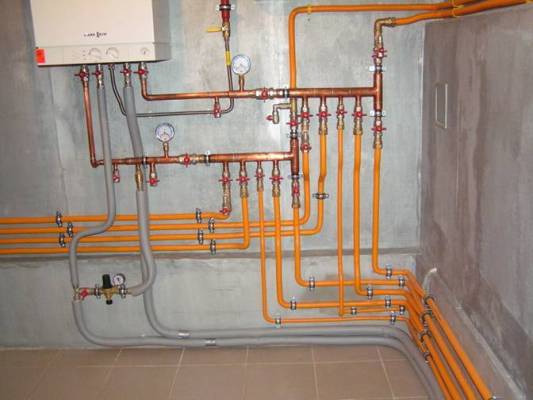

It should be said right away that there is no universal strapping. In each specific case, you will need to take into account your specificity of the heater and those elements that will be present in the system. But there are a number of rules and equipment that are always present. When tying with polypropylene, regardless of the type of fuel and the boiler itself, the system must contain:
- single-circuit or double-circuit boiler;
- expansion tank - an ordinary tank (for a natural system) or a hydraulic one with a membrane (for a forced system);
- polypropylene pipes and fittings for them;
- radiators - can be made of steel, cast iron, aluminum or bimetal;
- bypasses - are used in more complex piping systems, as they allow you to disconnect certain sections of the water supply from the circuit.
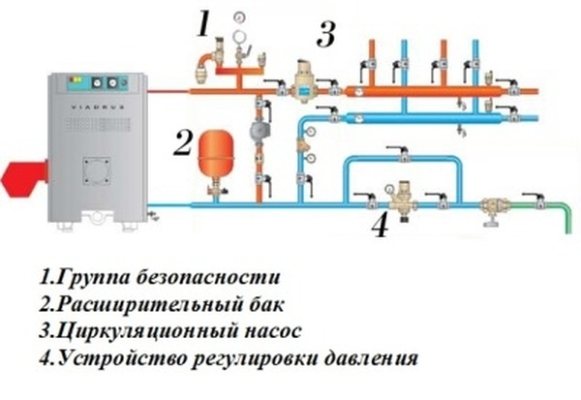

The heating system can be of two types - natural and forced. In the first case, the coolant moves through the pipes according to the laws of physics, and in the second, a circulation pump is included in the piping. Therefore, with a forced type, in addition to all of the above elements, it will also be necessary to install a Mayevsky crane and a pump.
If the scheme involves the supply of a coolant to each device through individual lines, then a collector is needed for this. Such a device ensures the supply and return of water through pipes. When there is a need to regulate the qualitative and quantitative characteristics, then additional control devices are also built into the system - a pressure gauge, a thermostat and a hydraulic arrow.
The harness has its own nuances, which you need to get acquainted with without fail.Otherwise, there is no guarantee that the heating system will work properly. Depending on the type of boiler, such work can be done independently or you can invite professionals. But if you are not confident in your abilities, then it is better to immediately seek help from the masters.
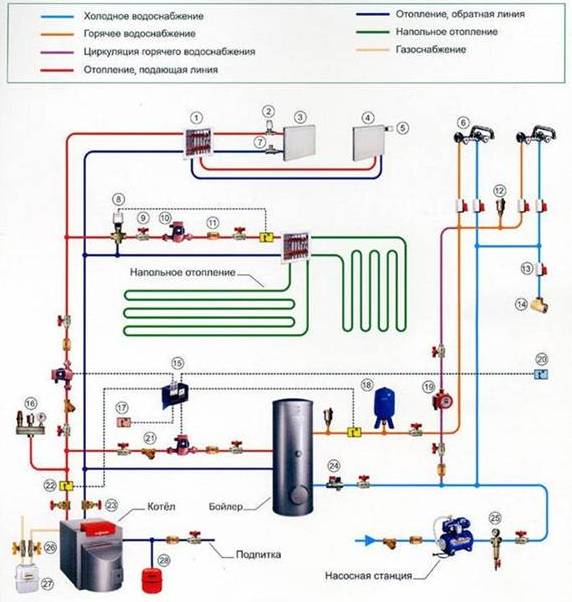

Pipes
With the help of pipes, the gas boiler is connected to the heating system, and the coolant is diluted in the right directions.
If the design of an autonomous heating system is performed correctly, its parameters are characterized by absolute stability and controllability:
- Temperature inside convection circuits (equipped with radiators or convectors). Should not be more than + 75-80 degrees. Heating of warm floors does not exceed + 25-35 degrees.
- Pressure. Allowable limits: 1 - 2.5 kgf / cm2.
If the circulation pump fails, the thermostat will almost instantly stop the combustion process. This will protect the coolant from overheating and boiling. For this reason, the switching of the boiler and the heating distribution is often realized with polymer and metal-polymer pipes, which saves on the purchase of expensive metal products.
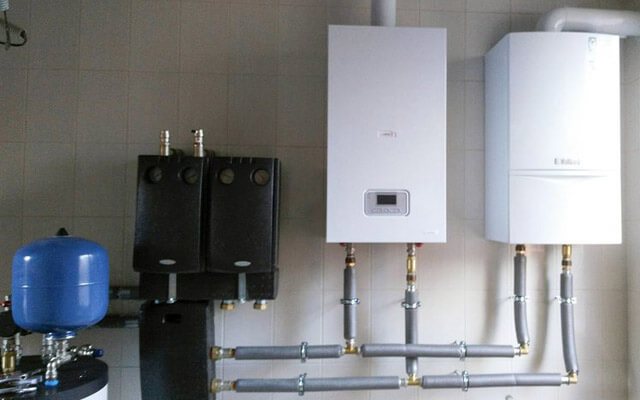

A few recommendations:
- For the implementation of sequential wiring of radiators and switching the boiler, metal-plastic pipes with press fittings are most often used. Another common option is polypropylene products with aluminum reinforcement.
- When installing threaded fittings for metal-plastic, special care must be taken: if the O-rings move at least a little, this will lead to a leak. As a rule, such a nuisance should be expected after several heating-cooling cycles.
- Unreinforced polypropylene (or glass fiber reinforced) has a very high elongation ratio. An increase in temperature by 50 degrees provokes an elongation of each meter of the pipe by about 6.5 and 3.1 mm, respectively. This option is also unsuitable.
- To organize radial wiring or underfloor heating, metal-plastic pipes on press fittings, pipes made of cross-linked polyethylene or thermally modified polyethylene are also used.
Specificity of piping boilers with polypropylene
There are a number of nuances that owners of private houses should be aware of who have opted for polypropylene products (in more detail: "Do-it-yourself installation of a polypropylene heating system"). A huge advantage of polypropylene pipes is the ability to perform heating circuits of various configurations.
To connect the elements of the pipeline, when the boiler is strapped with polypropylene, you can use not only the welding technology, but also use fittings selected in accordance with the size of the pipes. But the second method is less reliable. In case of slight movements in the fittings location, leaks may occur (read: "Polypropylene pipes for heating: dimensions").
When arranging the heating system on your own, it should be remembered that the simpler the design diagram, the easier it will be to complete the work. The complexity not only complicates the installation, but also significantly reduces the efficiency of the heating structure.
Experts advise that when creating a heating system, use the smallest number of connection points. If possible, make all transitions smooth.
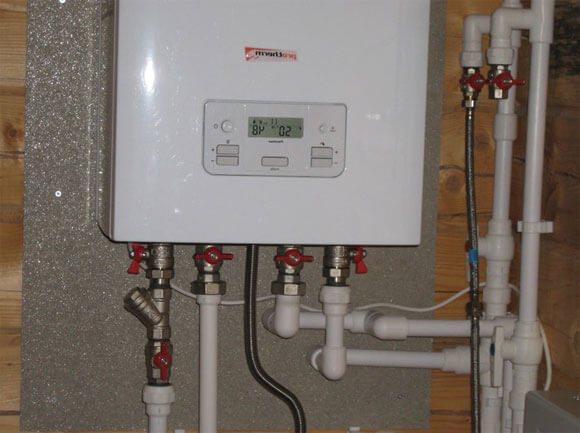

Installation of a polypropylene pipeline provides:
- system operation for 40 years;
- ability to withstand pressures exceeding 25 bar;
- the safety of pipes even under the condition of circulation of a coolant having a temperature of 95 degrees (in more detail: "Do-it-yourself installation of a heating system from polypropylene pipes").
Despite the advantages of this material of manufacture, there are a number of restrictions that must be taken into account if the heating boiler is piped with polypropylene, when the gas supply is used for the operation of the unit (about
Varieties of heating schemes for a private house
In the simplest version of the boiler diagram, there is no piping at all.In the overwhelming majority of cases, the factory equipment of boilers with electronic ignition consists of the following elements: a pump, an expansion tank, an automatic air vent and a valve (with a pressure setting of 2.5 kgf / cm2). The location of all piping units is the body: as a result, the complex is transformed into a mini-boiler room.
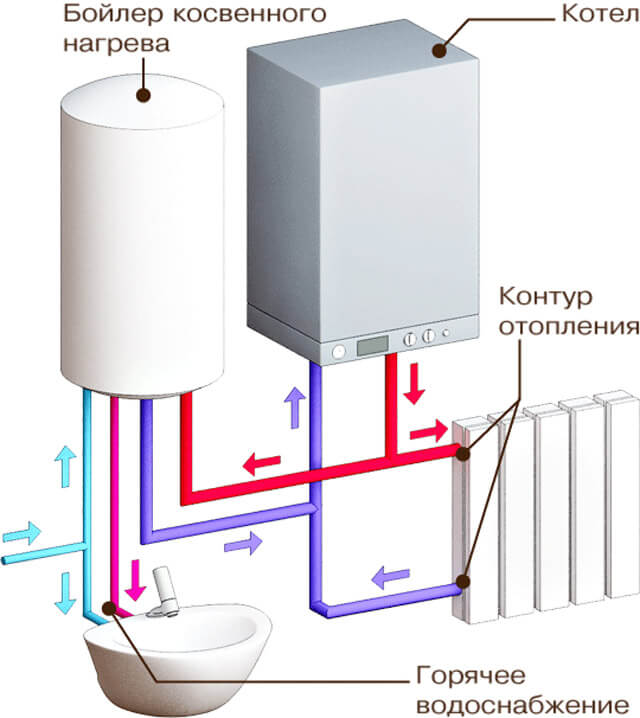

As additional elements, the system can be equipped with:
- Filter. The place of its installation is the inlet pipe. As a result, the heat exchanger receives protection from contamination, with an increase in the hydraulic resistance of the circuit. This leads to a decrease in the speed of movement of the coolant, and the pump itself experiences an additional load.
- Ball valves. They are installed at the entrance and exit sections. This makes it possible to dismantle the heat exchanger or boiler, while maintaining the heating circuit.
Strapping options
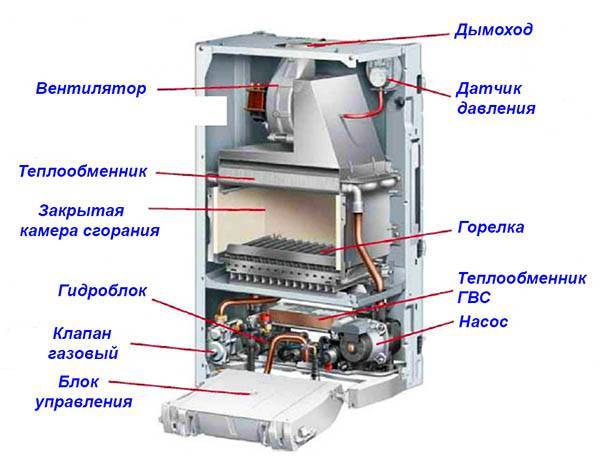

The device of a wall-mounted boiler with a closed combustion chamber
The choice of a piping scheme that is optimally suitable for a system of a given configuration directly depends on the specific version of the purchased boiler equipment sample. According to the method of placement within the premises chosen for it and the design of the liner, these units are divided into the following classes:
- typical floor standing boilers;
- lightweight (compact) wall devices.
The main requirement for the installation of units installed on the floor is to prohibit the insertion of their working pipes into the upper section of the pipeline routing.
If this rule is violated, when piping a floor-standing boiler in systems that are not equipped with air valves, very dangerous formations (plugs) will appear. To reduce the likelihood of their appearance in the absence of valves, the pipe into which the boiler crashes should be located strictly vertically and have a special expansion tank in the upper part.
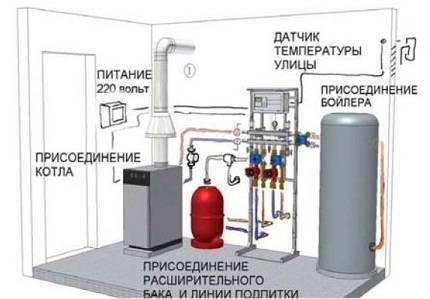

The piping scheme should be oriented towards the uniformity of heat supply to all devices
In the lower zone of units of all categories, automatic devices are provided to ensure their reliable connection to the heating main. Unlike the boiler installed on the floor, its wall-mounted counterparts already have an expansion mechanism that eliminates the formation of jams. When considering piping schemes for boiler rooms for such systems, it should be borne in mind that the advantage of wall-mounted models - low weight and not too large dimensions - are at the same time their disadvantage. This is due to the fact that compact units from DWG, for example, are limited in their energy capabilities. This means that the capacity declared by this manufacturer is sufficient for heating buildings with an area of no more than 100 square meters. Therefore, these devices are especially popular with city apartment owners.
A distinctive feature is the presence of two versions, differing in their configuration. The complete set of equipment includes most of the strapping elements, and the incomplete set lacks some units, which are purchased by the user independently.
Floor standing gas boilers with piezo ignition
Piezo-fired boilers and floor-standing equipment do not belong to mini-boiler rooms: we are talking about heating devices that need external piping.
It includes:
- Pump. To select the pump capacity, the formula Q = 0.86R / Dt is used (Q is the capacity in m3 / h, R is the thermal power of the boiler or a separate circuit, Dt is the temperature difference between the supply and return). In order for the convection heating system with gas boilers to work normally, the temperature difference must be 20 degrees (+ 75-80 degrees on the supply, and + 55-60 on the return pipeline). A boiler power of 36 kW assumes the presence of the following reasonable minimum pump performance - 0.86x36 / 20 = 1.548 m3 / h.
- Diaphragm expansion tank.
- Safety valve.
- Automatic air vent.
- Pressure gauge.
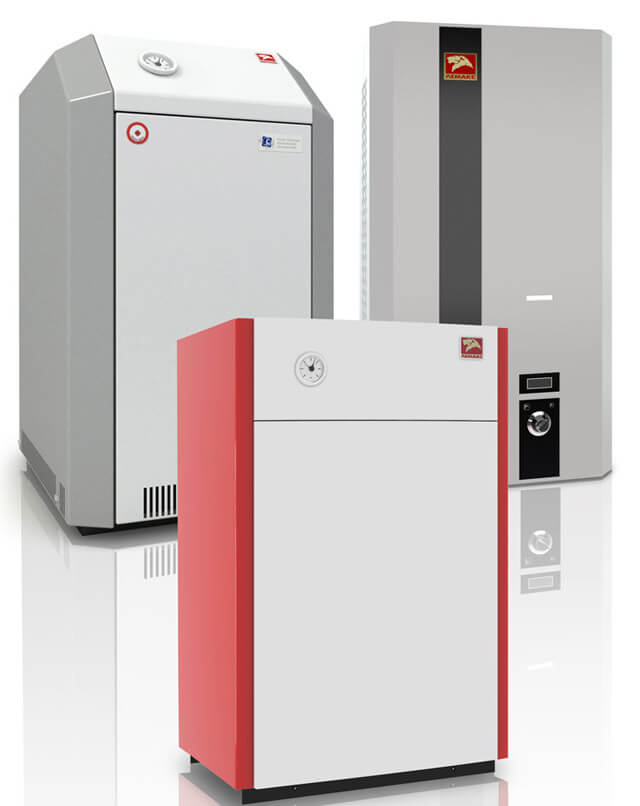

The optimal location for the safety group is the boiler outlet: it is here that the temperature and pressure indicators reach their maximum values. The pump is placed in front of the boiler, in the area with the lowest coolant temperature (this allows you to significantly extend the service life of the impeller and rubber seals). The expansion tank can be mounted anywhere in the system: the main thing is that the distance to the pump impeller is no more than two diameters (if it is installed in front of the pump).
When installed after the pump, this distance is increased to eight diameters. This distance is necessary so that pressure surges occurring during pump operation do not reduce the life of the tank membrane. To prevent condensation from appearing, the heat exchanger is often equipped with an additional small circulation circuit. If the return pipe is cooled, a hotter coolant is added inside it (it is taken from the supply pipe by means of a mixing unit).
Single-circuit gas boiler piping
A simple piping system for a gas boiler with one circuit is compiled based on the characteristics and requirements of the heating unit. A check valve and a ball valve are mounted on the supply side. A pump is mounted on the return and delivery pipes, which ensures the circulation of the liquid and the uniform distribution of the coolant throughout the rooms.
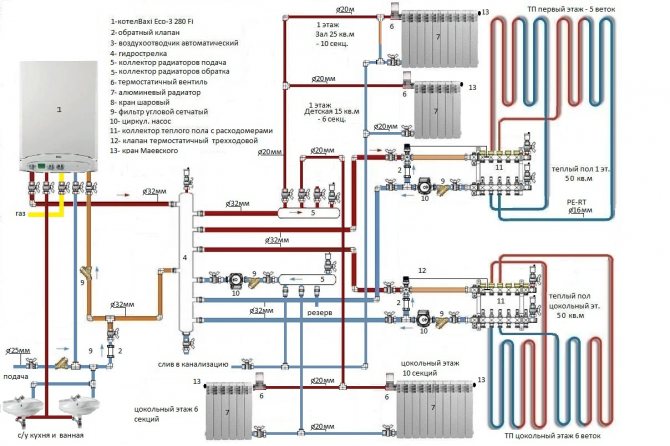

Example of piping a boiler for a private house
A mesh filter is installed in front of it, which is placed with a sump down. Before the liquid enters the boiler, experts recommend installing a fine filter. Closer to the boiler, there should be a closed expansion tank. It contains a membrane that provides the ability to relieve pressure during thermal expansion of the liquid. From the pump, the coolant moves along the circuit to the radiators.
The decoupling through the collector is considered more modern - a special water collector, from which the liquid is distributed along several circuits. The collector is located in a special cabinet from which the coolant is distributed through the pipelines.
A safety valve is included in the piping diagram of the gas boiler. When the coolant boils, due to overheating, the expansion tank may simply not withstand pressure drops and, because of this, a malfunction will occur, which is fraught with the following consequences:
- pipeline breaks and connection leaks;
- destruction of pipes and fittings;
- explosion of the boiler capacity.
The safety valve is mounted as close as possible to the boiler, because the pressure builds up in it. Some instruments are equipped with safety groups, which include a relief valve, an automatic air vent and a pressure gauge.
The devices are installed in the water jacket of the boiler, but can also be installed on pipelines. On units operating on gas and electricity, such devices can be replaced by others.
There are a large number of ways by which it is possible to connect the described elements to the boiler, they are classified based on what kind of coolant circulation in the system: natural or forced.
Natural circulation
The gravity system is characterized by complete energy independence: its operation is ensured by atmospheric pressure. Instead of a bulky safety group in the piping of a single-circuit boiler, it is enough to have an expansion tank. It is advisable to install a vent for filling in front of the boiler heat exchanger: this will make it possible to completely drain the water into the sewer or drainage well. Typically, such a need arises in the event of a long trip, or when the gas supply is cut off. As a result, the system is protected from defrosting.
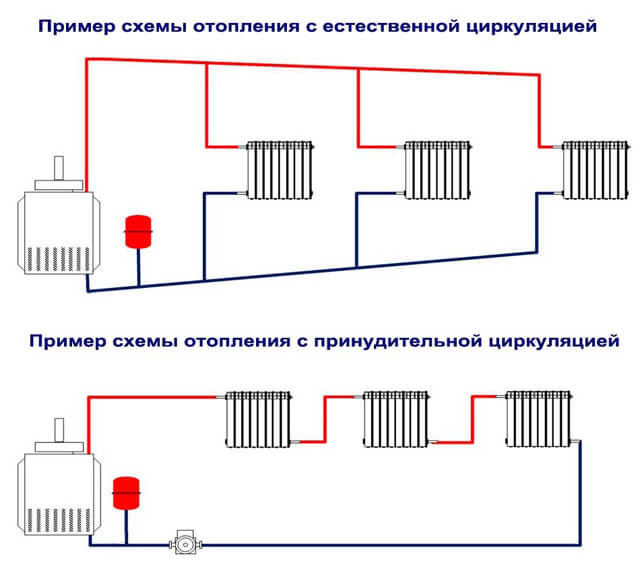

The individual units of the system are located as follows:
- It is recommended to install the tank above all other elements.
- The filling located immediately after the boiler is positioned in the vertical direction (a small angle is allowed). Thanks to the booster section, the water heated in the heat exchanger rises to the upper filling point of the supply.
- It is important to maintain a constant slope when laying the filling after the cistern. As a result, the cooling water will return by gravity: in this case, air bubbles will be able to escape inside the expansion tank.
- The boiler must be lowered as low as possible. The best place to place the heater is in a pit, basement or basement. Due to the difference in height between the heat exchanger and the heaters, the proper level of hydraulic pressure is ensured to circulate the water in the circuit.
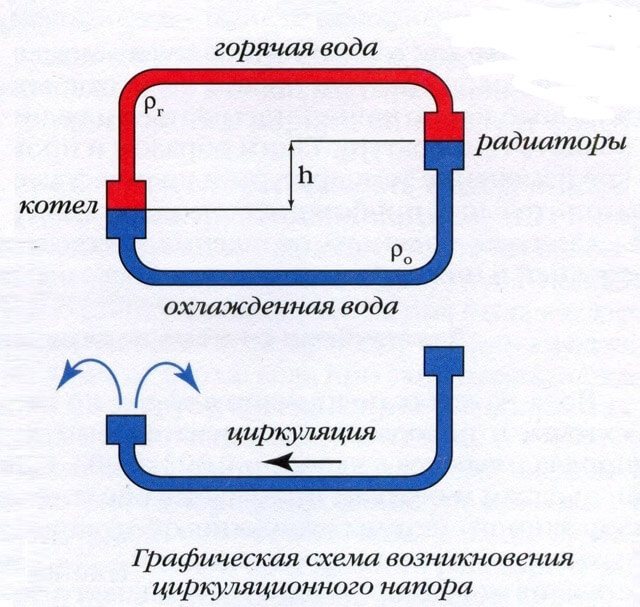

Some features of the arrangement of an inertial heating system:
- For the inner diameter of the filling, an indicator of 32 mm or more is selected. If plastic or metal-plastic pipes are used, then the outer diameter is 40 mm. Due to the large cross-section, compensation of the minimum hydraulic head is achieved, due to which the coolant moves.
- The gravitational system sometimes includes a pump: however, this does not mean that the circuit loses its energy independence. In this case, the pump is not mounted in the gap of the filling, but parallel to it. A ball-type check valve is used to connect individual connections, which is characterized by a very low hydraulic resistance. A ball valve is also installed. In the event that the pump stops, the bypass is closed, which preserves the operability of the circuit with natural circulation.
Hydrostrel
This node includes both contours:
- The first uses the movement of the coolant between the hydraulic arrow and the boiler heat exchanger.
- In the second, one or more heating circuits with different heating levels are commuted to it.
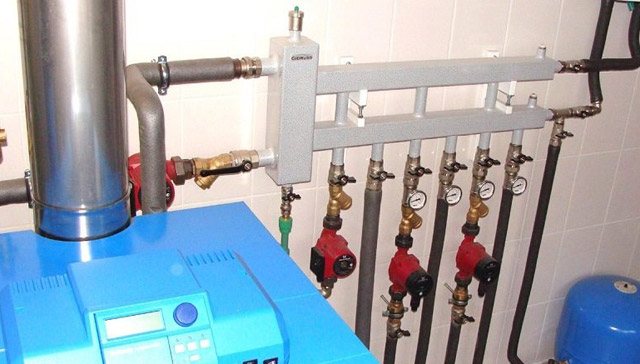

The principles of operation are as follows:
- The vertical hydraulic arrow makes it possible to select a coolant of different temperatures. The top will be hot and the bottom will be cold.
- When taking water from the upper pair of outlets, commutation of convection heating is allowed. The bottom pair is used in the in-floor scheme.
- The temperature indicator of the coolant below the switching level of the return pipe of the circuit at the junction of the hydraulic switch and the boiler can significantly drop.
Recirculation
In a parallel position to the main radiator heating circuit or a small circuit in the section from the boiler to the hydraulic arrow, a low-temperature circuit is being arranged. It includes a bypass and a three-way thermostatic valve. Thanks to the pump, water is constantly circulating inside the pipes of the underfloor heating.
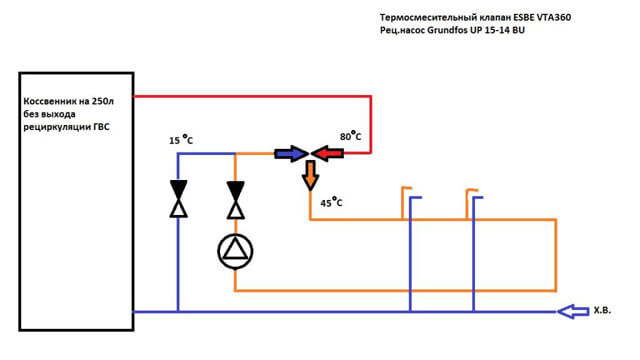

A three-way mixer is used to take new portions of the hot coolant from the supply pipe when the temperature inside the return flow drops. It can be replaced with a simple thermostatic valve equipped with a capillary-type remote temperature sensor or an electric thermocouple. The place of installation of the sensor is a niche on the return line of the warm floor. The valve is triggered when the coolant temperature drops.
Radiator connection in series
This option is possible if a condensing gas boiler is used, because the operation of classic equipment is difficult at a return temperature below +55 degrees. The fact is that a cooled heat exchanger collects condensate on its surface. The gas combustion products contain, along with water and carbon dioxide, corrosive acids. In this case, there is a real threat of destruction of steel or copper heat exchangers.
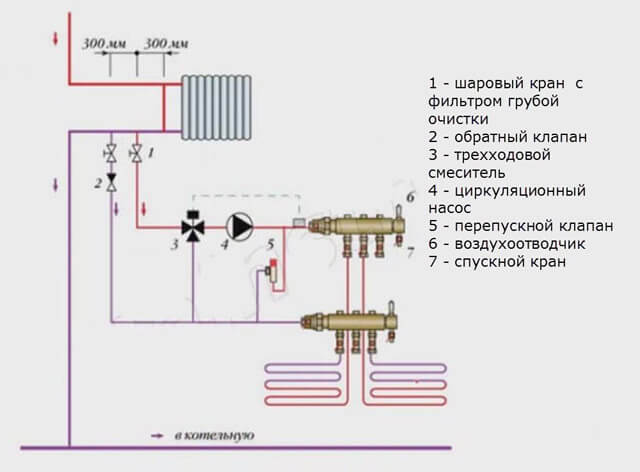

Condensing boilers have a different operating principle. A special stainless steel heat exchanger (economizer) is used to collect combustion products. As a result, there is an additional heat transfer and an increase in the efficiency of the equipment.Because of this, the temperature level of the return pipe of + 30-40 degrees is optimal. The heating system consists of two circuits connected in series - radiator and floor. The return pipe of the first is the supply pipe of the second.
Features of piping single-circuit and 2-circuit boilers
The main difference between the existing methods of organizing the piping of heating systems is their energy capabilities. The power of single-circuit boilers, as a rule, is enough only to heat the structure - to heat the batteries. Such a unit does not allow heating water for domestic needs, which the consumer will have to take care of separately. 2-circuit boilers can not only heat the house, but also heat the water necessary for washing dishes or taking a shower.
The principle of operation of a 2-circuit boiler
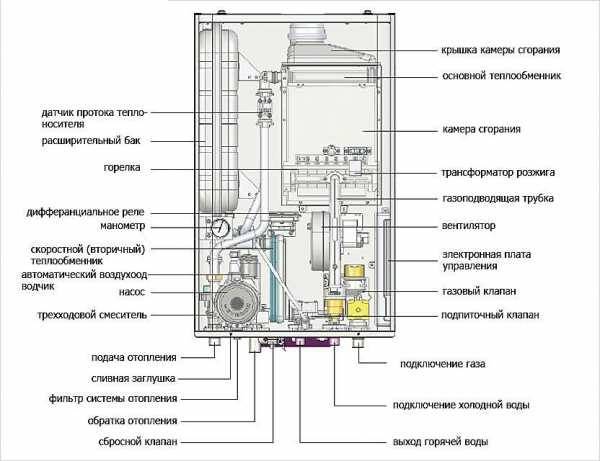

Double-circuit boiler design
The design of these units provides for a special heat exchange unit (heat accumulator) designed for heating water and having two versions:
- flow-through products with the "domination of hot water supply" mode;
- units equipped with a built-in boiler.
If you need to take a shower or just wash the dishes, in the first case, it is enough to switch to this mode, after which the 2nd DHW circuit will be connected to the boiler. This performance is typical for units of domestic and foreign production. The piping of a double-circuit flow-type boiler is optimal for houses or city apartments of a not too large area (up to 75-86 sq. Meters), since not very powerful heat exchangers are built into these units.
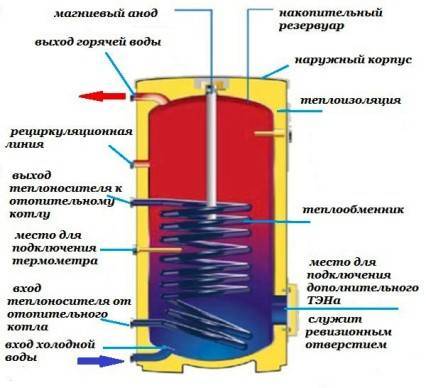

The principle of operation of a boiler for heating water
It is a completely different matter - boilers equipped with a storage boiler, in which the tank capacity varies from 160 to 190 liters. They are intended for heating water both in storage and in flow mode.
Boiler models, even at the production stage, are equipped with a special heat exchanger, in which separately circulating water is heated by the energy of the heat carrier of the main heating circuit. For their normal operation, the manufacturer provides a special valve that controls the direction of movement of the energy carrier. The principle of domination of the DHW system is as follows:
- when the valve is in the closed position, the heat carrier, heated to a predetermined level, circulates through the heating system, heating the living space;
- if one of the residents opens the hot water tap, the boiler stops heating water for heating and continues to heat it in the boiler, while the second heating circuit is inactive;
- after the valve on the hot water pipeline closes, the system immediately directs the coolant to the batteries.
The principle of operation and the device of a single-circuit strapping
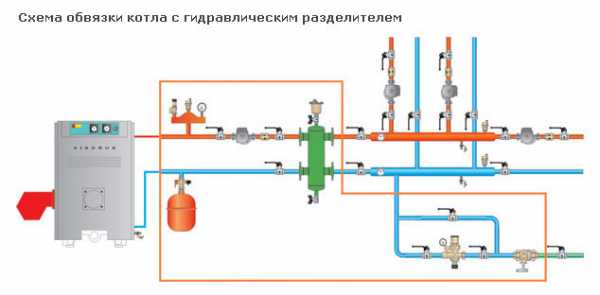

With a single-circuit tying of the boiler, there is one heat exchanger in its structure, which heats water only for the heating system. If you want to get warm liquid for washing dishes from it, you will need to purchase and mount an indirect heating boiler nearby. Its main element is a combustion chamber with a gas burner located in it and a coil, on top of which a heat exchanger is located.
The liquid in the system circulates in a natural way, or a water pump is used for this purpose.
In most single-circuit models, it is possible to connect polypropylene pipes from the boiler to them. After that, the one-pipe system begins to operate in a 2-circuit mode, while observing the principle of priority.
Single-circuit boilers with hot water supply
To provide hot water supply, along with a safety group, a pump and an expansion tank, the piping of a single-circuit gas boiler must include an indirect heating boiler. A possible connection diagram for an indirect heating boiler with recirculation.In this case, the water is heated thanks to the heat carrier from the heating circuit. This leads to the appearance of two circulation circuits - large (through the heating system) and small (through the boiler). Each of them has shut-off valves, which allows them to be switched on separately. To break the filling of the supply, a piping scheme is used for a single-circuit boiler with a boiler, immediately behind which a bypass with a tap is mounted.
Wall mounted gas boiler piping
Gas boilers can be mounted on the wall in the kitchen. They are very compact and can be placed even in small rooms. The piping of a wall-mounted gas boiler is included in the kit and can even be built into the boiler.
As a disadvantage of wall-mounted units, we can note the low power. In addition, such a heating device cannot function without electricity, and the natural circulation of the coolant is not characteristic of them. On the other hand, almost all boiler models are equipped with electronics and require electricity. In areas with unstable supply, you can install an uninterruptible power supply.
Many wall-mounted models provide for piping a double-circuit heating boiler, the circuit of which makes it possible to provide the house with hot water.
The disadvantage of a double-circuit unit is the shutdown of heating during the period of hot water consumption. This is especially noticeable with a low boiler output. If it is enough, the temperature of the coolant drops by only a couple of degrees in a few hours.

